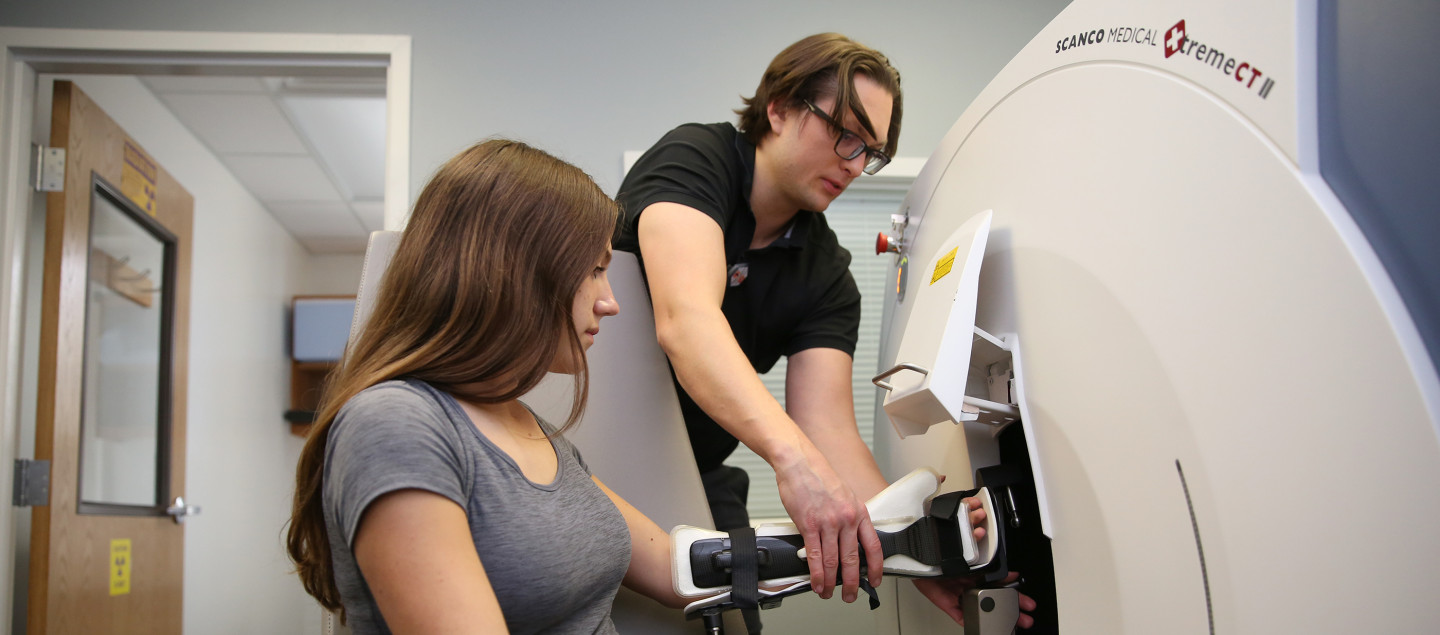Cutting-edge device allows FACS researchers an up-close look at bone health

In saving for retirement or building healthy bones, it’s important to start early.
Joseph Kindler, a bone researcher and assistant professor in the College of Family and Consumer Sciences, uses the financial investment analogy to emphasize how critical the early years are in establishing long-term health of bones.
“When we get into our adult years, it’s incredibly challenging to address bone health issues that have already occurred,” he said. “That’s why when we think about preventing facture and other bone-related health issues, we talk about optimizing bone health during the years you’re going to get the most return on investment in terms of depositing mineral, and that’s really during childhood, adolescence and young adulthood.”
Kindler, who directs the Nutritional and Skeletal Health Lab within the department of nutritional sciences, said his team’s mission is to identify ways to enhance attainment of peak bone mass during the formative years through diet, physical activity and other health-related behaviors.
Another focus of the lab is addressing issues facing people with less than optimum bone mass due to chronic diseases, medications or genetic predispositions.
“In people who are vulnerable to bone health complications, we want to figure out ways to recoup lost opportunities for investment into their ‘bone bank,’ ” Kindler said. “One way to do this is by addressing nutrition shortfalls.”
What is peak bone mass?
Peak bone mass is a theoretical concept at which an individual meets their full potential with respect to bone health. The bone is about 90 percent heritable, but the remaining 10 percent can mean all the difference in terms of ensuring strong, compact bones and decreasing the risk for osteoporosis, Kindler said.
Traditionally, calcium and vitamin D have been put on a pedestal as nutrients that promote strong bones, and for good reason. The bone is a reservoir for calcium storage.
Kindler’s lab is expanding bone health research to include a “whole diet” view, specifically how the overall quality of diet impacts the bone and how severe picky eating or malnutrition may be contributing factors.
The lab also looks at the miscommunications between the gut and skeleton as a reason for bone health problems that arise in people with complex disease. A main focus of the lab is in cystic fibrosis, a genetic condition that adversely impacts nutrition status and bone health.
Kindler is currently leading a series of studies involving bone fragility in people with cystic fibrosis as a main component of his Georgia Clinical and Translational Science Alliance (CTSA) KL2 grant.
The role of new technology
Bone researchers have long relied on dual X-ray absorptiometry, or DXA, scans, a non-invasive approach that uses low-dose radiation to assess overall bone mass and body composition and to diagnose osteoporosis.
DXA scans provide a snapshot of a person’s bone health, but require a significant amount of time to measure how bone health might be impacted by a chronic disease or a nutrition or behavioral intervention.
To complement the standard DXA scans, Kindler’s lab recently installed a state-of-the-art high-resolution peripheral quantitative computed tomography (HR-pQCT) scanner, a new device that allows researchers to assess nuanced microstructural features of the bone that are more quickly adapted to interventions.
Kindler’s lab employs the second generation of the device, one of only about 20 devices in use in North America and typically found in major medical institutions with a strong pipeline to patient population.
“It enhances our precision of how we assess bone health, which could decrease the amount of time potentially needed to run clinical studies to monitor the response of interventions,” Kindler said. “These insights are more indicative of a bone’s ability to not break if it’s put up against a lot of stress, and that’s the most important thing.”
Working in tandem with the DXA scanner, the new technology provides a more comprehensive view of the forces at work impacting bone health that then allows researchers to more quickly translate it into patient populations.
The advances in technology only heightens the importance of collaboration among researchers, clinicians with access to patient populations and public health practitioners to accelerate progress in the field, Kindler said.
“It gives us an opportunity at UGA to think beyond the typical application of this device solely in clinical populations so that we can think how this can inform other efforts in line with the land-grant mission of UGA,” Kindler said. “We can apply this technology and figure out evidence-based strategies for promoting bone health, leveraging integral components of our land-grant system. It’s a challenge, but we look at it more as an opportunity.”
In this category: Nutrition
-
Search for safe seafood broth recipe in the works
Researchers see opportunity to leverage seafood as an alternative or complementary food source

-
Interested in the vegetarian lifestyle? Here are a few tips
Faculty member Emma Laing offers advice on how to make the transition smoother
